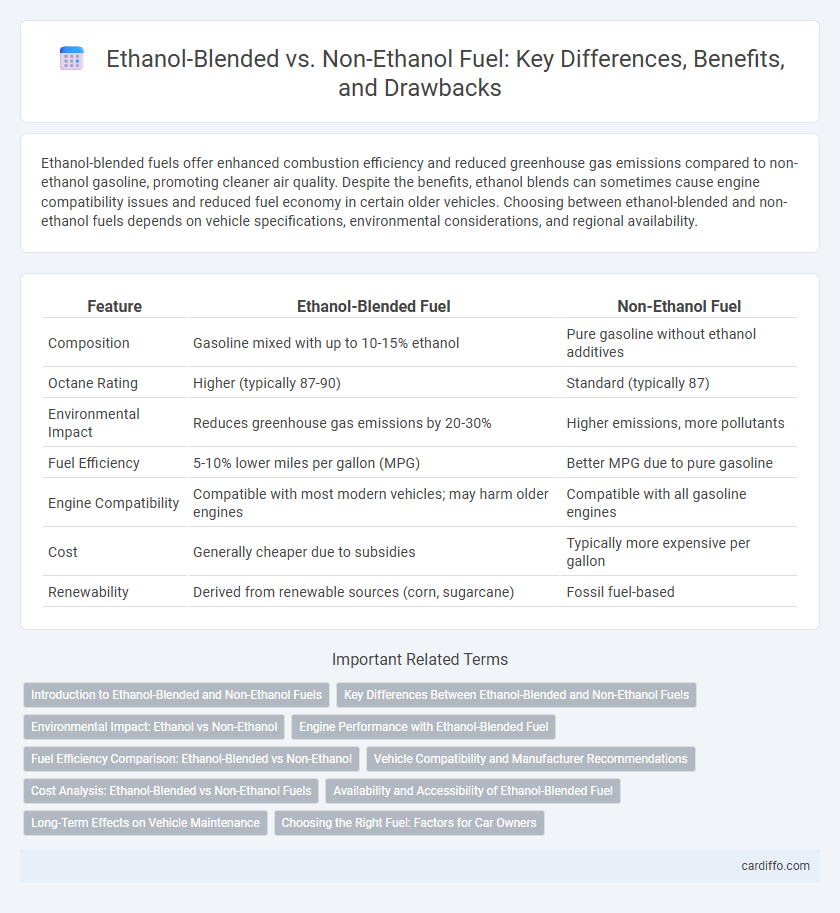Ethanol-blended fuels offer enhanced combustion efficiency and reduced greenhouse gas emissions compared to non-ethanol gasoline, promoting cleaner air quality. Despite the benefits, ethanol blends can sometimes cause engine compatibility issues and reduced fuel economy in certain older vehicles. Choosing between ethanol-blended and non-ethanol fuels depends on vehicle specifications, environmental considerations, and regional availability.
Table of Comparison
| Feature | Ethanol-Blended Fuel | Non-Ethanol Fuel |
|---|---|---|
| Composition | Gasoline mixed with up to 10-15% ethanol | Pure gasoline without ethanol additives |
| Octane Rating | Higher (typically 87-90) | Standard (typically 87) |
| Environmental Impact | Reduces greenhouse gas emissions by 20-30% | Higher emissions, more pollutants |
| Fuel Efficiency | 5-10% lower miles per gallon (MPG) | Better MPG due to pure gasoline |
| Engine Compatibility | Compatible with most modern vehicles; may harm older engines | Compatible with all gasoline engines |
| Cost | Generally cheaper due to subsidies | Typically more expensive per gallon |
| Renewability | Derived from renewable sources (corn, sugarcane) | Fossil fuel-based |
Introduction to Ethanol-Blended and Non-Ethanol Fuels
Ethanol-blended fuels contain a percentage of ethanol mixed with gasoline, commonly ranging from 10% to 15%, designed to reduce emissions and reliance on fossil fuels. Non-ethanol fuels consist purely of gasoline without ethanol additives, often preferred for older engines and certain small engines due to their chemical stability. Choosing between ethanol-blended and non-ethanol fuels impacts engine performance, fuel economy, and environmental factors in various automotive and machinery applications.
Key Differences Between Ethanol-Blended and Non-Ethanol Fuels
Ethanol-blended fuels typically contain 10-15% ethanol mixed with gasoline, enhancing octane levels and reducing greenhouse gas emissions compared to non-ethanol fuels. Non-ethanol fuels offer higher energy content per gallon, resulting in better fuel efficiency and engine performance for sensitive engines. Ethanol blends are renewable and promote cleaner combustion, while non-ethanol fuels provide greater compatibility with older vehicles and small engines prone to ethanol-related damage.
Environmental Impact: Ethanol vs Non-Ethanol
Ethanol-blended fuels reduce greenhouse gas emissions by up to 34% compared to non-ethanol gasoline, significantly lowering carbon footprints in transportation. The renewable nature of ethanol, often derived from corn or sugarcane, supports sustainable fuel cycles and decreases reliance on fossil fuels. Non-ethanol fuels, while energy-dense, typically contribute higher levels of pollutants like carbon monoxide and particulate matter, exacerbating air quality issues and climate change.
Engine Performance with Ethanol-Blended Fuel
Ethanol-blended fuel improves engine performance by providing higher octane ratings, which enhance combustion efficiency and reduce knocking. It also promotes cleaner burning, leading to lower carbon deposits and improved engine cleanliness over time. Engines designed for ethanol blends benefit from better throttle response and potentially increased power output under standard operating conditions.
Fuel Efficiency Comparison: Ethanol-Blended vs Non-Ethanol
Ethanol-blended fuels typically contain 10-15% ethanol, which has a lower energy density than pure gasoline, resulting in a slight decrease in fuel efficiency of about 3-5%. Non-ethanol fuels provide higher miles per gallon (MPG) due to their higher energy content and lack of oxygenates that can reduce combustion energy. Studies indicate that vehicles using non-ethanol fuel often achieve better fuel economy, especially in engines optimized for pure gasoline combustion.
Vehicle Compatibility and Manufacturer Recommendations
Ethanol-blended fuels, typically containing up to 10-15% ethanol, are widely compatible with modern gasoline vehicles designed to handle these blends, offering benefits such as reduced emissions and renewable content. Non-ethanol gasoline, preferred by classic car enthusiasts and certain small engine applications, avoids potential issues like phase separation and fuel system corrosion linked to ethanol. Manufacturers often recommend ethanol-blended fuels for most new vehicles due to improved combustion efficiency, but advise verifying compatibility in owner's manuals to prevent engine damage and maintain warranty coverage.
Cost Analysis: Ethanol-Blended vs Non-Ethanol Fuels
Ethanol-blended fuels typically offer cost savings due to lower production expenses and government subsidies promoting renewable energy. Non-ethanol fuels, while often more expensive, provide higher energy content per gallon, potentially reducing consumption over time. Comparative cost analysis must factor in fuel efficiency, environmental benefits, and regional price variations to determine the economically optimal choice.
Availability and Accessibility of Ethanol-Blended Fuel
Ethanol-blended fuel is widely available at gas stations across the United States, particularly in the Midwest where corn production is high, promoting its accessibility for consumers. The U.S. Environmental Protection Agency mandates renewable fuel standards, increasing ethanol blend levels such as E10 and E15 in the national fuel supply, which improves availability even in urban areas. Non-ethanol fuels remain accessible but are less common, often found in specific markets like marine or small engine fuel due to regulations and supply chain constraints.
Long-Term Effects on Vehicle Maintenance
Ethanol-blended fuels can cause increased wear on engine components and fuel systems over time due to their corrosive properties and higher evaporation rate, potentially leading to clogged fuel filters and degraded rubber seals. Non-ethanol fuels tend to preserve engine longevity better by reducing the risk of moisture absorption and phase separation, thus minimizing maintenance needs such as fuel injector cleaning and valve deposit removal. Choosing non-ethanol fuel often results in lower long-term maintenance costs and improved overall vehicle performance stability.
Choosing the Right Fuel: Factors for Car Owners
Ethanol-blended fuels typically contain 10-15% ethanol, offering cleaner emissions and reduced greenhouse gas output compared to non-ethanol gasoline, which is purely petroleum-based. Car owners should consider engine compatibility, as certain vehicles, especially older models or small engines, may experience corrosion or reduced fuel efficiency with ethanol blends. Evaluating factors like fuel economy, environmental impact, and manufacturer recommendations ensures optimal performance and longevity when choosing between ethanol-blended and non-ethanol fuels.
Ethanol-Blended vs Non-Ethanol Infographic

 cardiffo.com
cardiffo.com